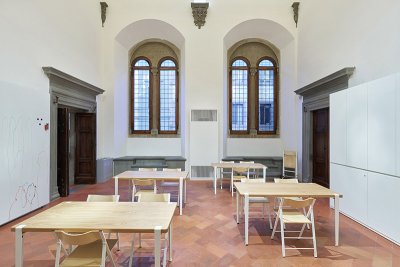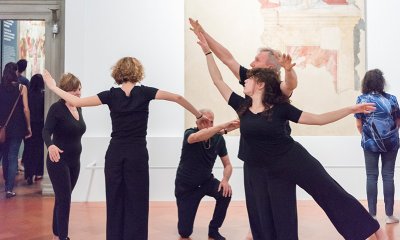With Many Voices is a scheme devoted to people living with dementia and their caregivers which the Fondazione Palazzo Strozzi first launched in 2011. For each exhibition we organise a cycle of encounters designed for families and people in residential care homes, offering a pleasurable, stimulating and emotionally uplifting experience for sharing and seeking ways of communicating through the emotions triggered by works of art.
With Many Voices takes place in front of the works in the exhibition and in the rooms of the Maria Manetti Shrem Educational Centre, an inclusive space accessible to all audiences and the heart of the Fondazione Palazzo Strozzi’s educational activities.
The encounters are devised and conducted by Palazzo Strozzi’s museum educators together with geriatric educators Luca Carli Ballola and Michela Mei.
Art, words, dementia
Art lies at the heart of the scheme and all participants are encouraged to observe and to express their personal opinions in the presence of the exhibits on display in Palazzo Strozzi.
There are no right or wrong answers and each participant, whether senior citizen or caregiver, can share expressions, gestures and words. In With Many Voices each work of art is thus enriched with endless interpretations, and dialogue opens up new opportunities for establishing a relationship between the exhibit and the observer, between those conducting the activity and the participants, and between those suffering from dementia and their caregivers.
Observation of the exhibit on display can be completed by the creation of a story or a collective composition via a guided conversation to which each person makes a contribution with his or her own means of expression. Everything said is meticulously transcribed and published at the end of each exhibition.
Since the spring of 2016 the scheme has been supplemented by a workshop devised and conducted with artists. Virginia Zanetti (2016), Cristina Pancini (2017), Marina Arienzale (2018) and Caterina Sbrana (2019) have all taken part in With Many Voices.
The goals of With Many Voices
With Many Voices sets out primarily to make Palazzo Strozzi’s exhibitions accessible to people with dementia and to their caregivers. The scheme is based on an approach that considers relationships to be the chief tool for improving one’s quality of life, with reference to Pietro Vigorelli’s capacitating approach, Naomi Feil’s validation and Moyra Jones’ “gentle care“. These models all share a focus on each individual’s capability rather than on the deficiencies they have built up, and on the goal of “possible well-being” rather than on an (impossible) recovery of all their functions.
With Many Voices focuses on the ability to observe, to feel emotions, to imagine, all capabilities that are maintained for longer than their logical and cognitive counterparts in people with dementia, and it also allows people who have built up major cognitive deficiency to take part. This, because the kind of activity proposed and the educators’ professional guidance allow everyone to participate to a satisfactory degree, turning their loss of restraint and mental interpretative patterns into greater freedom of judgment and ease of imagination. That is why keeping alive the ability to use words and to converse, indulging the need to express deep-seated emotions and being listened to and respected are the most important ways of showing each individual that they are acknowledged as people and thus of rebuilding their social status.
Other important aims in the scheme involve caregivers (be they family members or professionals) who are shown a new way of communicating: living a gratifying and exciting experience in a stimulating and prestigious environment, in the course of which everyone can show themselves to be capable of responding to the requests made of them, entails a recovery of self-esteem in terms of one’s ability to address a situation while also providing an instant sensation of well-being.
The scheme also sets out to prompt a change in society’s perception of this condition through encounters with the public in the exhibition, offering people with Alzheimer’s and their family members new opportunities for social relations and reducing the stigma attached to those experiencing this situation of fragility.
With Many Voices in remote mode
With Many Voices‘ activities take place primarily in front of works of art, yet starting in April 2020 we also activated a number of on-line modalities that allowed us to stay in touch during the health crisis, an especially difficult moment for families having to cope with the stress of dementia. These remote solutions also proved to be useful after lockdown because they have allowed us to maintain a link with those who, for one reason or another, are unable to take part in person.
Our remote programme takes the form of encounters via Zoom and activities posted to specially created WhatsApp groups. Through these two channels we suggest experiments for performing in the home in connection with art projects and works of art on display in Palazzo Strozzi and capable of helping participants to overcome the tribulations of isolation. The words and images posted during lockdown have been collected and published.
To tie in with Marinella Senatore’s major installation in the courtyard of Palazzo Strozzi entitled We Rise by Lifting Others, participants in the With Many Voices scheme were involved in the digital workshops devised by the artist and conducted by choreographers Elisa Zucchetti and Nandhan Molinaro. Each participant was invited, via the screen, to focus on the use of their body and to create a non-verbal narrative that led to the discovery of new possibilities for remote involvement.
The networks
Dialogue with the territory and a will to share with other institutions are important tools for improving proposals and for finding new solutions, which is why, in the context of the With Many Voices scheme, we constantly seek out dialogue with other national and international entities, organising seminars on accessibility at Palazzo Strozzi and subscribing to the Musei Toscani per l’Alzheimer system.
Since 2016, the Fondazione has also been running a specific training course for museums and entities wishing in their turn to launch projects and schemes for people suffering from dementia. To date the course has spawned projects and schemes in Verona (Musei Civici), Venice (Palazzo Grassi – Punta della Dogana), Lugano (Museo Vincenzo Vela) and Reggio Emilia (Palazzo Magnani) and Ravenna (Fondazione RavennaAntica).
These initiatives are designed to maintain ongoing dialogue with cultural institutions in order to build up a common heritage of experiences and skills allowing us to pool and to share the culture of accessibility.
With Many Voices publications
– With Many Voices for the exhibition Ai Weiwei. Libero
– With Many Voices for the exhibition Bill Viola. Electronic Renaissance
– With Many Voices for the exhibition The Cinquecento in Florence
– With Many Voices for the exhibition Dawn of a Nation
– With Many Voices for the exhibition Marina Abramović. The Cleaner
– With Many Voices for the exhibition Verrocchio, master of Leonardo
– With Many Voices for the project In Touch
– With Many Voices for the exhibition Jeff Koons. Shine
– With Many Voices for the exhibition Reaching for the stars
– With Many Voices for the exhibition Anish Kapoor. Untrue Unreal
Collaborations with artists
– Muri, project with Virginia Zanetti for the exhibition Ai Weiwei. Libero
– Caterina, project with Cristina Pancini for the exhibition Bill Viola. Electronic Renaissance
– Leggieri, project with Cristina Pancini for the exhibition The Cinquecento in Florence
– Stormi possibili, collective experience with Marina Arienzale for the exhibition Dawn of a Nation
The project renews itself from exhibition to exhibition.
Participation is free, reservation is required.
For information: edu@palazzostrozzi.org















